Learn to make the popular Gujiya recipe that is a classic North Indian sweet of crisp, flaky pastry filled with khoya (milk solids) and nuts stuffing. Gujia is generally fried but in this recipe post, I am sharing both the fried and baked versions. Take your pick and enjoy making these traditional sweet for Holi or Diwali festival.
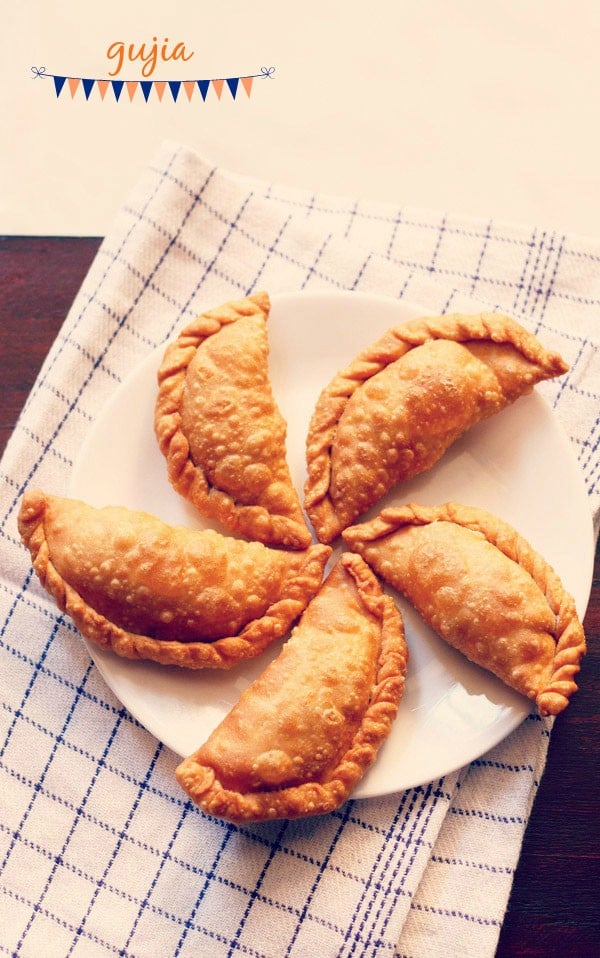
Table of Contents
What is Gujiya
Gujiya are crescent shaped filled pastry that are deep fried. The traditional gujiya recipe has a filling of sweeetned khoya or mawa (milk solids), cardamom and some nuts.
These delish fried pastries resembles the Mexican empanadas. In fact gujia are very much popular in North India, especially during the Holi festival.
You will get to see many variations of gujiya in the sweet shops during Holi. Gujia is made on both Holi and Diwali festivals.
On the eve of Holi I make either Puran Poli, Karanji or gujiya.
Gujiya vs Karanji
Karanji and gujiya are similar sweets, except for the stuffing.
Karanji which is popular in Maharashtra has a stuffing of coconut, poppy seeds, sesame seeds and nuts.
Whereas guijiya has a stuffing of khoya or mawa (dried milk solid)with nuts, dry fruits. In some variations desiccated coconut is also added. But I do not add coconut to the khoya stuffing.
The varied and unique fillings give a completely different taste, texture and flavor to both the gujiya and karanji.
About Gujiya Recipe
My gujiya recipe is the traditional North Indian recipe and is made with the stuffing of khoya (mawa), sugar and nuts.
Generally, in a gujia, the outer pastry is made of all-purpose flour. But you can break away from the norm and make the pastry dough with whole wheat flour.
In this recipe, I have included half-half of both all-purpose flour and whole wheat flour.
I baked some gujiya and fried the rest and have illustrated both the baking and fried methods in the step by step guide.
Texture and taste wise the fried gujiya are definitely much better. However for health reasons and to cut down on the fat you can easily bake them when making this gujiya recipe.
How to make Gujiya
Make Pastry Dough
1. In a bowl take 1 cup whole wheat flour (atta), 1 cup all-purpose flour (maida) and ¼ teaspoon salt.
You can include 2 cups of all-purpose flour OR 2 cups of whole wheat flour. Overall you need 2 cups of flour + ¼ teaspoon salt.
*Do check the Notes section of the recipe card to know about water proportion if using only whole wheat flour or all-purpose flour.
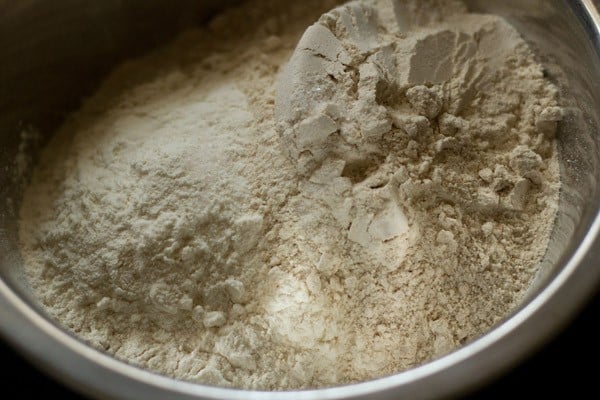
2. Heat 2 tablespoons ghee (clarified butter) in a small pan or bowl until it melts and becomes warm.
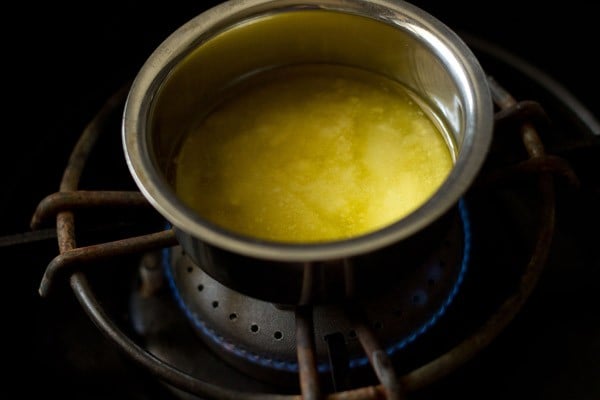
3. Pour the warm ghee on the flours.
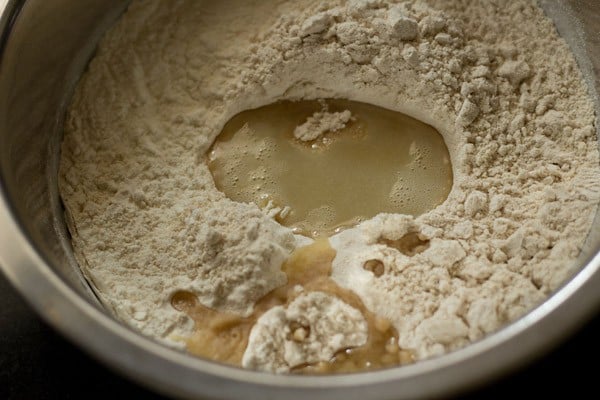
4. First mix with a spoon. Then rub and mix the ghee with the flours, with your fingertips to form a bread crumb like texture.
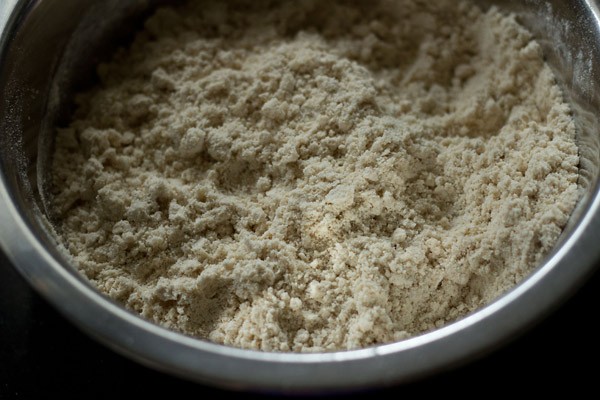
5. Add ⅓ to ½ cup water in parts and begin to knead. The amount of water needed will depend on the quality and texture of flour.
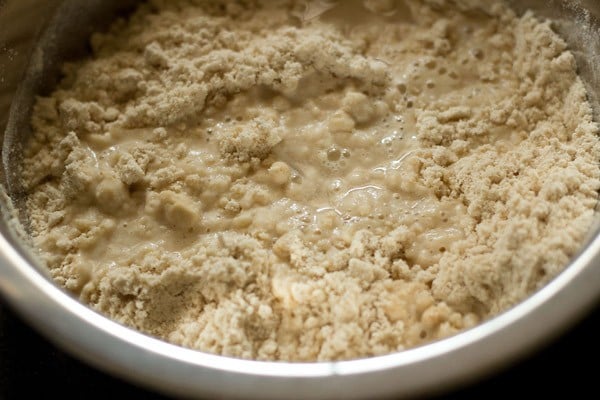
6. Knead the dough until it is firm and tight.
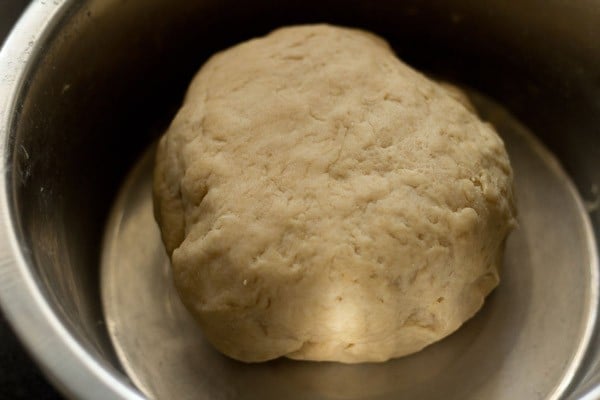
7. Cover with a moist kitchen napkin and set aside for 30 minutes.
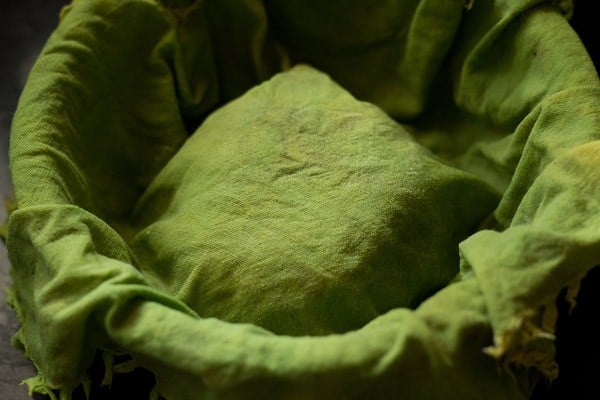
Make Stuffing
8. Chop 10 cashews, 10 almonds, 10 pistachios and ½ tablespoon raisins. Set aside.
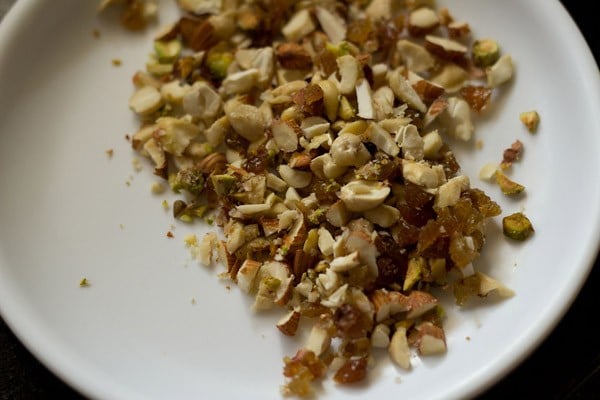
9. Melt ½ tablespoon ghee in a pan on a low heat.
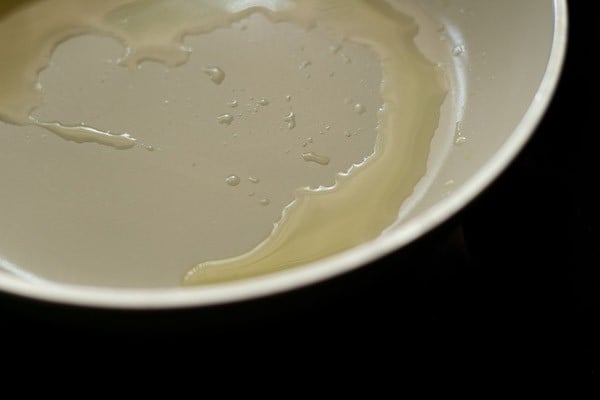
10. Add 1 cup crumbled or grated khoya. Khoya can be made at home or purchased from the market.
To know how to make khoya, you can check this method of making traditional Khoya (Mawa).
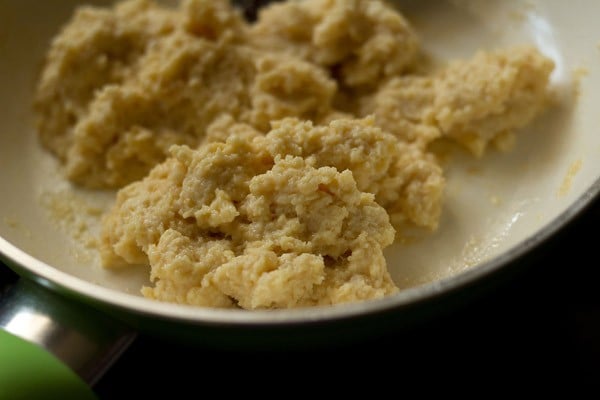
11. Stir the khoya continuously on a low heat.
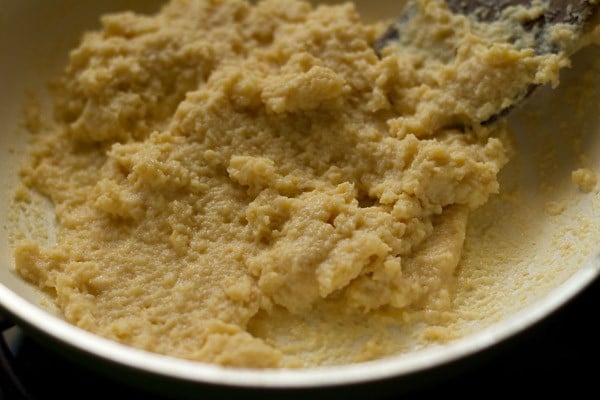
12. Cook the khoya until it begins to gather around itself. Switch off the heat and place the pan on the kitchen countertop.
Let the khoya stuffing cool completely at room temperature. You can even transfer the khoya stuffing to a plate and let it cool.
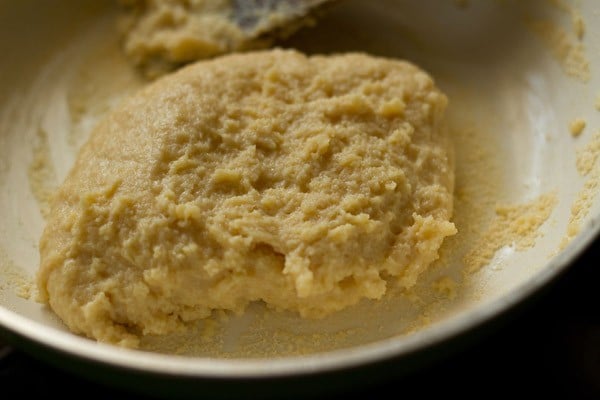
13. Add ⅓ cup powdered sugar (or confectioner’s sugar), the chopped nuts, raisins and ½ teaspoon cardamom powder. I suggest to to sieve the powdered sugar if there are lumps. This makes the mixing easier.
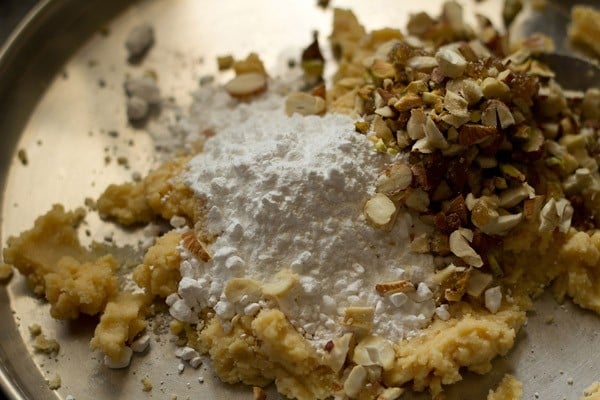
14. Mix everything well and keep the stuffing aside. Check the taste and add more powdered sugar if you prefer.
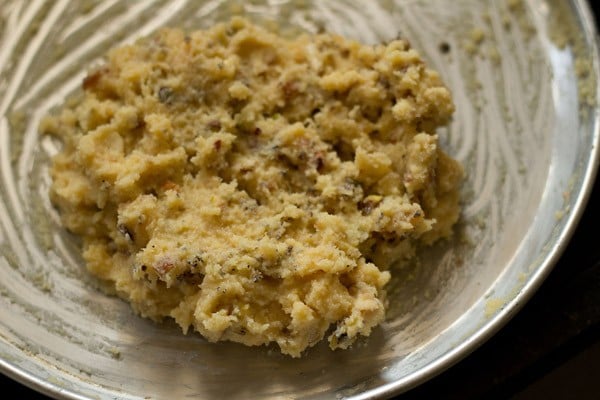
Assemble
15. Divide the dough into two parts.
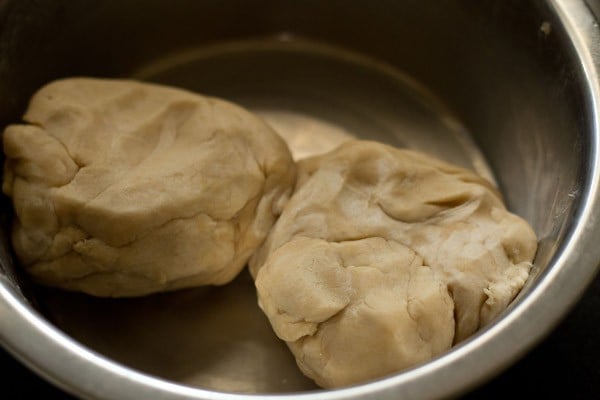
16. Make a medium-sized log of each part and slice or portion it into equal parts.
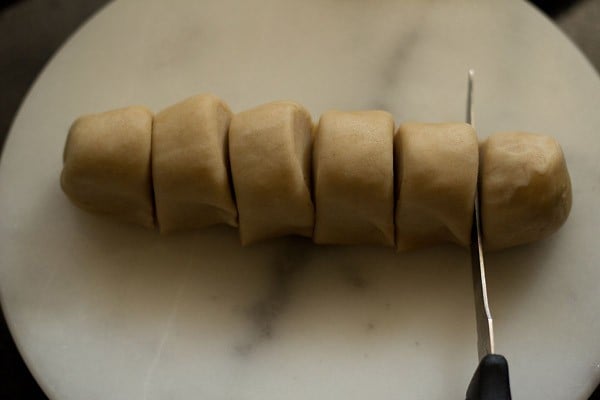
17. Roll each part in your palms to form a ball. Prepare all the dough balls this way and place them in the same bowl. Cover with a moist kitchen towel.
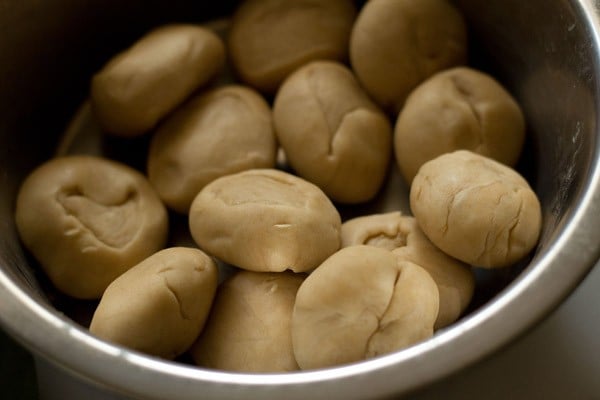
18. Dust the rolling board lightly with some flour. Roll each ball with the rolling pin to a small circle having 4 to 5 inches diameter.
Use less flour and if possible you can avoid the flour for dusting completely.
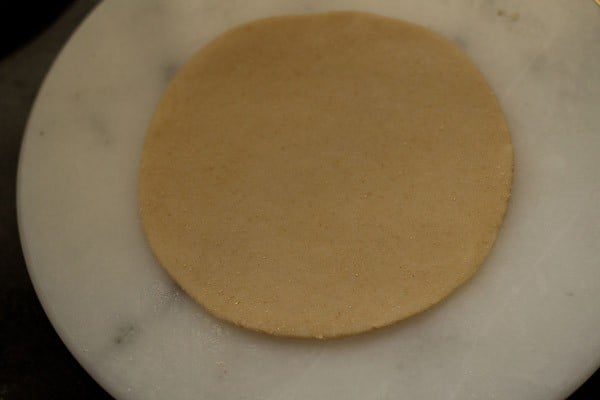
19. with your fingertip or a pastry brush, apply water all over the circumference edge.
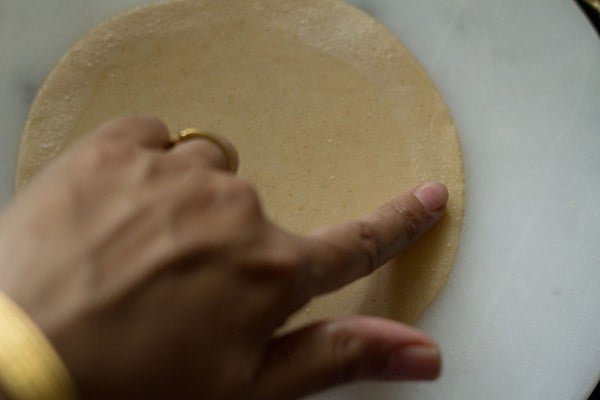
20. Place about 1 to 1.5 tablespoons of the the prepared khoya filling on one side of the circle, keeping the edges empty.
Don’t add too much of the stuffing as it becomes difficult to shape the gujia and this can lead to them breaking in the oil while frying.
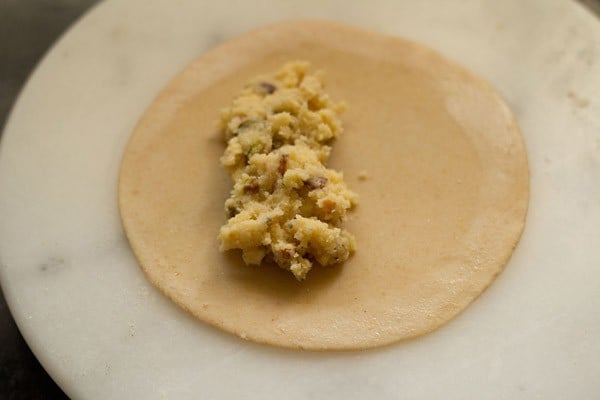
Shape for Baking
21. Carefully, bring together both the edges and join. Gently press the edges. The edges have to be pressed well and sealed, so that the filling does not come out while frying.
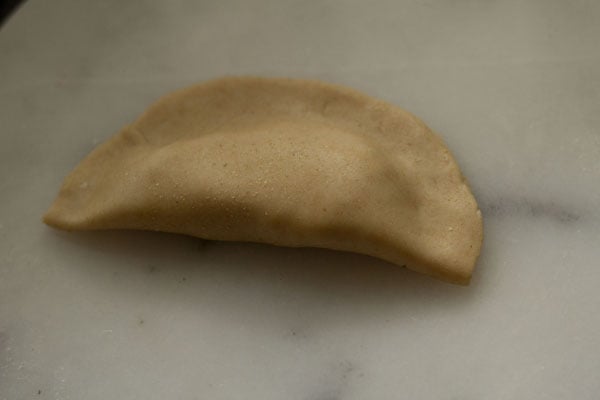
22. With a gujiya/karanji cutter or small pizza cutter, trim the extra edges. When doing this method, it is very important that the gujiya is pressed and sealed well.
Note: Avoid this method of cutting the edges, if you plan to fry the gujiya. If baking then this method is good. As even if the filling comes out, you don’t have to worry, as there is no mess.
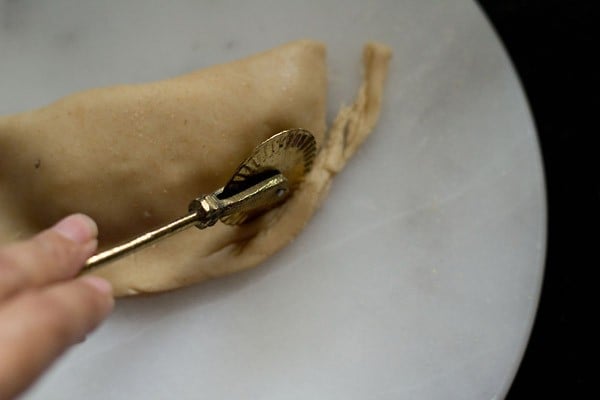
23. The neatly trimmed gujiya photo below.
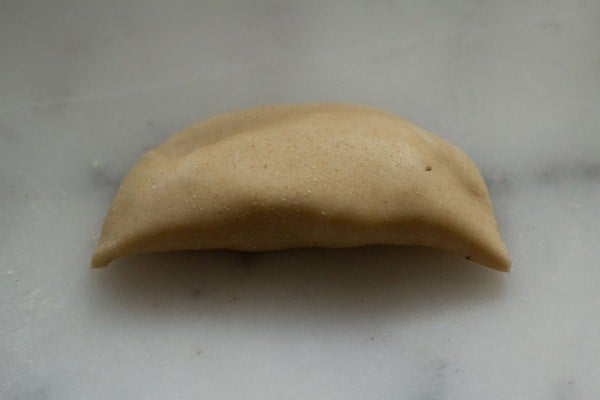
Shape for Frying
24. For deep frying, it is best to make pleated design at the edges. This way the stuffing does not come out while frying and the gujiya looks good too. Just keep on folding and twisting the edges till the end.
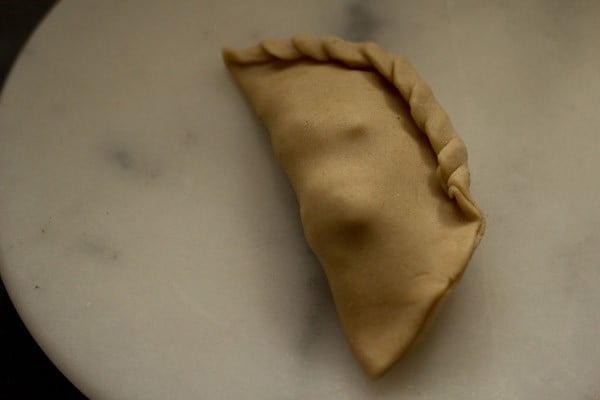
25. Prepare gujiya this way and arrange them on a plate or tray. Keep them covered with a moist napkin so that the dough does not dry out.
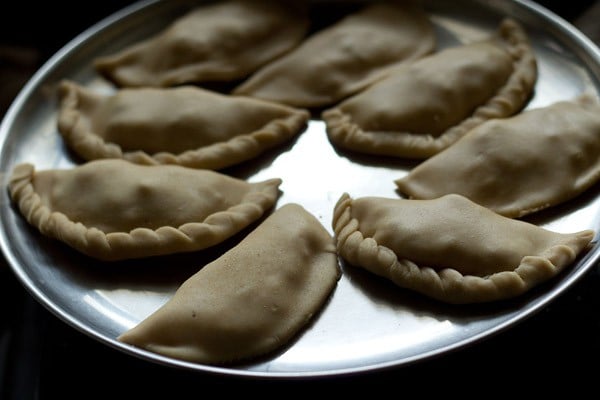
Bake Gujiya
26. Preheat the oven to 200 degrees celsius (390 degree Fahrenheit). Brush oil or melted ghee on the gujiya evenly all over. If using oil, use a neutral flavored oil.
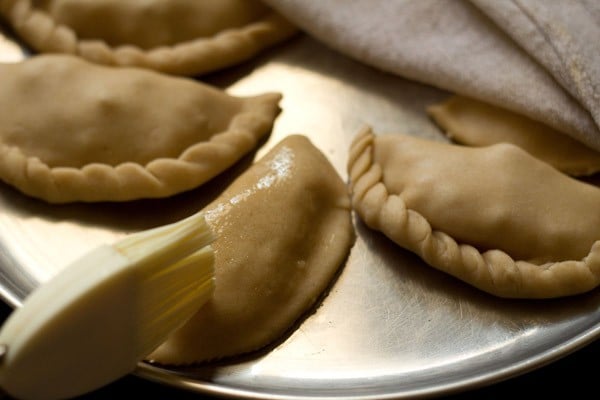
27. Place them on a baking tray.
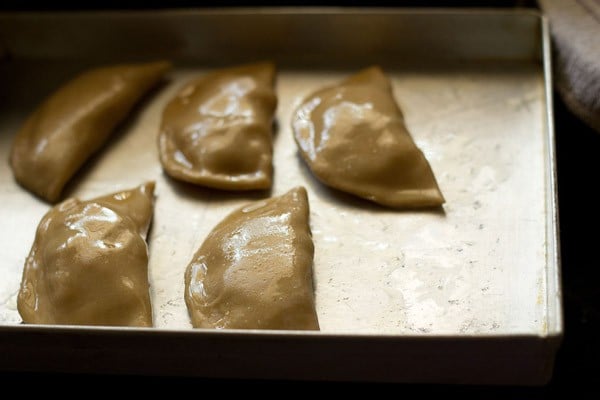
28. Bake the gujiya for 20 to 30 minutes at 200 degrees celsius (390 degree Fahrenheit) until they are golden.
Oven temperatures vary, so do keep a check while baking. Place them on a wired rack for cooling. Once cooled at room temperature, store the baked gujiya in an air-tight jar or box.
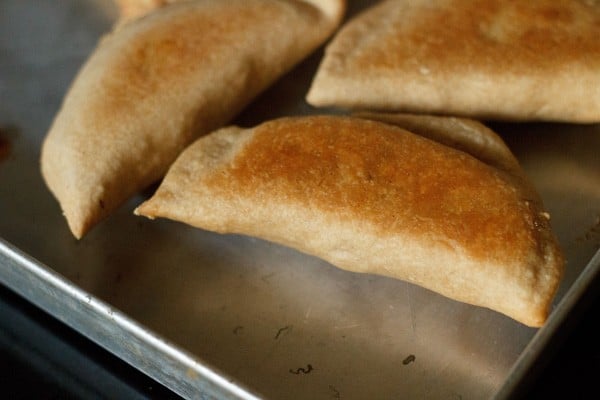
Fry Gujia
28. Heat oil for deep frying in a kadai or pan. First test the temperature of oil, before frying.
Add a small piece of the dough into the oil. If the dough comes up steadily and briskly, the oil is ready.
The oil is still cold if the dough sits at the bottom. If the piece of dough comes up briskly and quickly, the oil is too hot.
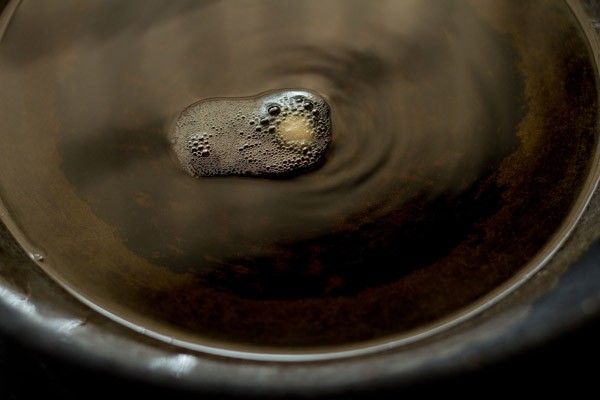
29. Gently slid the gujia in oil. Just add a few pieces and don’t overcrowd. Depending on the size of the pan/kadai, you can fry 2 to 3 gujiya at a time.
Fry gujiya at medium heat. If your pan or kadai is not heavy but light, then fry gujia at medium-low heat.
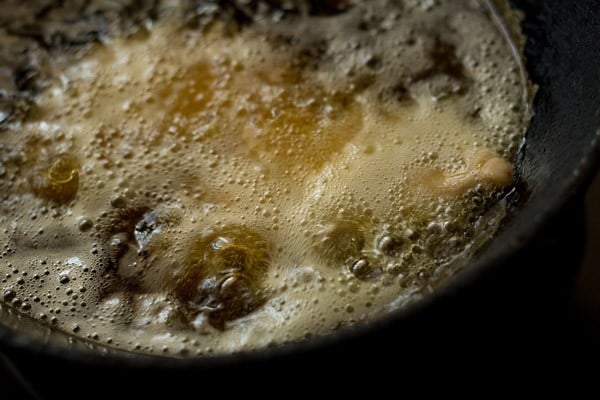
30. Turn them over carefully and fry the other side. Deep fry them till they have become golden turning over as needed.
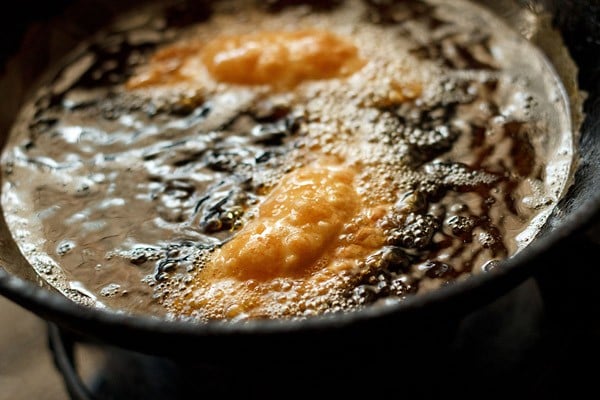
31. Place the fried gujia on kitchen paper tissues. Fry all the prepared gujiya in batches. Once they are cooled completely, store them in an air-tight box.
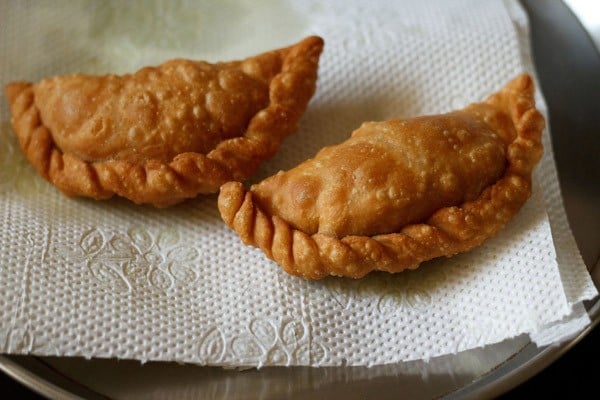
32. Serve gujiya to your family, friends and guests.
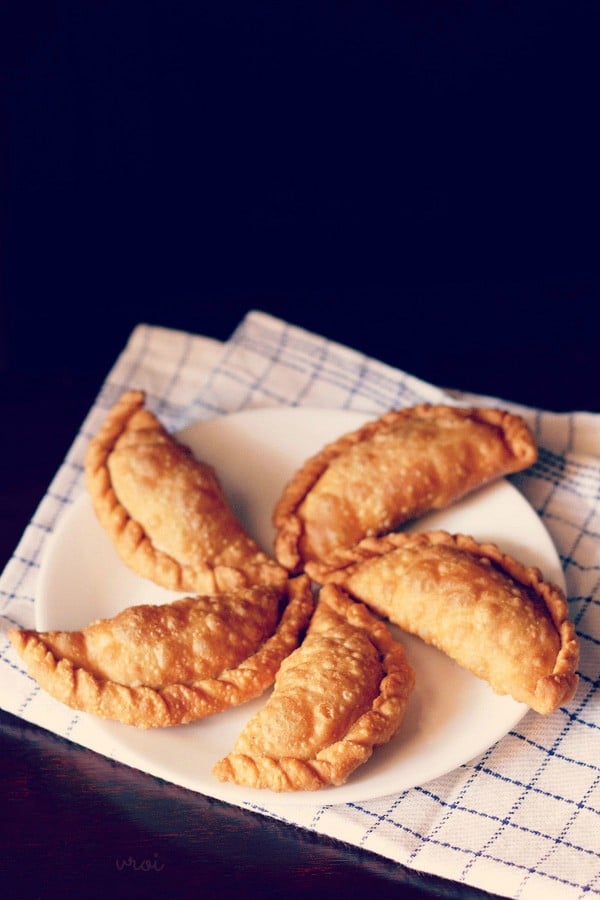
Serving Suggestions
Mawa gujiya is eaten like any Indian sweet as it is. If you fancy something more indulgent, pair the gujiya with some Rabri (thickened sweetened milk).
Storage
When the gujia cools at room temperature, immediately place them in an air-tight jar. They stay good for a few hours at room temperature. Since the stuffing is made with milk solids, I suggest to keep any leftovers in the refrigerator.
Expert Tips
- Dough: Knead the dough to a tight and firm dough. If the dough is soft, the outer pastry of the gujia will become soft.
- Oil temperature: The oil has to be medium hot while frying gujiya. If the oil is cool, the gujiya pastries will absorb a lot of oil making them soggy. They can break or fall apart while frying at a low temperature in the oil. If the oil is very hot, the outer part of the pastry will cook and get browned faster while the insides of the dough will be raw or undercooked.
- Stuffing variations: For variations in the stuffing of the gujiya recipe, you can include some thandai powder, gulkand (rose preserve), cocoa powder (for a chocolate flavored gujia) and any nuts or dry fruits you like.
- Flours and water: You can use the following proportions of flour – 2 cups of all-purpose flour or 2 cups of whole wheat flour.
If you use all-purpose flour, begin by adding ¼ cup water first and add a few tablespoons more as you go on mixing and kneading dough.
For whole wheat flour, start with ⅓ cup water and add some more tablespoons if needed. Thus add water in parts as you go on working the dough.
If the dough appears dry, then add more water and if the dough become sticky, then add more flour. - Scaling: To feed a crowd, make a large batch of this gujiya recipe. You can halve the recipe as well to make a small batch.
More Indian Sweets For You!
Sweets Recipes
Sweets Recipes
Sweets Recipes
Sweets Recipes
Please be sure to rate the recipe in the recipe card or leave a comment below if you have made it. For more vegetarian inspirations, Sign Up for my emails or follow me on Instagram, Youtube, Facebook, Pinterest or Twitter.
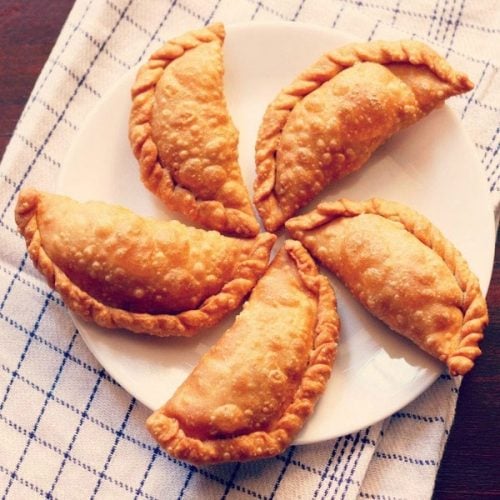
Gujiya Recipe (Fried and Baked)
Ingredients
For pastry dough
- 1 cup whole wheat flour – 120 grams
- 1 cup all-purpose flour – 125 grams
- ¼ teaspoon salt
- ⅓ to ½ cup water or add as required
- 2 tablespoons Ghee
For sweet stuffing
- 1 cup Khoya – tightly packed or 200 to 220 grams (mawa or evaporated milk solids)
- ½ tablespoon Ghee
- 10 almonds
- 10 cashews
- 10 pistachios
- ½ tablespoon raisins
- ⅓ cup powdered sugar or confectioner's sugar, add as required
- ½ teaspoon green cardamom powder or 6 to 7 green cardamoms powdered in a mortar
- oil as required for deep frying
Instructions
Making the pastry
- Take the all purpose flour, whole wheat flour and salt in a bowl.
- Heat ghee in a small pan or bowl until it melts and becomes warm. Pour the ghee on the flours.
- First mix the ghee with a spoon. Then rub and mix the ghee with the flours, with your fingertips to form a bread crumb like texture.
- Add water in parts and begin to knead. The amount of water needed will depend on the quality and texture of the flour.
- Knead the dough till firm and tight. Cover the dough with a moist cloth and set aside for 30 minutes.
Making sweet stuffing
- Crumble or grate the khoya (mawa).
- Chop the nuts, raisins and set aside.
- Melt ghee in a pan on a low heat.
- Add the crumbled or grated khoya.
- Stir the khoya continuously on a low heat.
- Cook the khoya, till it begins to gather around itself. Switch off the heat and place the pan on the kitchen countertop. Let the khoya stuffing cool completely at room temperature.
- Later add powdered sugar, the chopped nuts, raisins and cardamom powder. Better to sieve the powdered sugar if there are lumps.
- Mix everything well and keep the stuffing aside. Check the taste and add more sugar if you prefer.
Assembling and shaping
- Divide the dough into two parts.
- Make a medium log of each part and slice it into equal parts.
- Roll each part in your palms to make balls and place all the balls in the same bowl. Cover with a moist kitchen towel.
- Dust the rolling board lightly with some flour. Roll each ball with the rolling pin to a small circle having 4 to 5 inches diameter. Don't add too much flour while rolling. If you can roll without the flour, then it is better.
- With your fingertip or a pastry brush, apply water all over the circumference edge.
- Place about 1 to 1.5 tablespoon of the prepared khoya filling on one side of the circle, keeping the edges empty. Don’t add too much of stuffing as it becomes difficult to shape gujiya and they may break in the oil.
- Carefully, bring together both the edges and join. Gently press the edges.
- With a small gujiya cutter or pizza cutter, trim the extra edges. When doing this method, it is very important that the gujiya is pressed and sealed well. Avoid this method if you plan to fry the gujiya. If baking then this method is good. As even if the filling comes out, you don't have to worry as there is no mess.
- However, it is best to make pleated design at the edges if you plan to fry the gujiya. This way the stuffing does not come out while frying and the gujiya look good too. Just keep on folding and twisting the edges till the end.
- Prepare gujiya this way and arrange them on a plate or tray. Cover the guijya with a moist napkin so that the dough does not dry out.
Baking gujiya
- Preheat the oven to 200 degrees celsius (390 degree fahrenheit). Brush oil or melted ghee n the gujiya evenly all over.
- Place them in a baking tray.
- Bake the mawa gujiya for 20 to 30 minutes at 200 degrees Celsius (390 degree Fahrenheit), until they are golden. Oven temperatures vary, so do keep a check while baking. Place them on a wire rack for cooling. Once cooled, store them in an air-tight jar or box.
Frying gujiya
- Heat oil for deep frying in a kadai or pan.
- First test the temperature of oil, before frying. Add a small piece of the dough in the oil. If the dough comes up gradually and briskly, then the oil is ready. If the dough sits at the bottom, the oil is still cold. If the piece of dough comes up briskly and quickly, the oil is too hot.
- Gently slid the gujiya in oil. Just add a few pieces and don't overcrowd. At a time depending on the size of the pan/wok/kadai, you can fry 2 to 3 gujiya at a time on medium-heat.
- Turn them over carefully as fry the other side. Deep fry till they have become golden turning over as needed.
- Drain on kitchen paper tissues. Fry all gujiya this way and once they are cooled completely at room temperature, store them in an air-tight box.
- Serve gujiya to your family and guests when required.
Serving suggestions
- Gujiya is eaten like any Indian sweet as it is. If you fancy something more indulgent, pair the mawa gujiya with some Rabri (thickened sweetened milk).
Storage
- When the gujia cools at room temperature, immediately place them in an air-tight jar. They stay good for a few hours at room temperature. Since the stuffing is made with milk solids, I suggest to keep any leftovers in the refrigerator for about 1 to 2 days.
Notes
- * Flour and water: You can use the following proportions of flour – 2 cups of all-purpose flour or 2 cups of whole wheat flour. If you use all-purpose flour, begin by adding ¼ cup water first and add a few tablespoons more as you go on mixing and kneading dough. For whole wheat flour, start with ⅓ cup water and add some more tablespoons if needed. Thus add water in parts as you go on working the dough. If the dough appears dry, then add more water and if the dough become sticky, then add more flour.
- Dough: Knead the dough to a tight and firm dough. If the dough is soft, the outer texture will become soft.
- Oil temperature: The oil has to be medium hot while frying gujiya. If the oil is cool, the gujiya pastries will absorb a lot of oil making them soggy. They can break while frying at a low temperature in the oil. If the oil is very hot, the outer part of the pastry will cook and get browned faster while the insides of the dough will be raw or undercooked.
- Stuffing variations: For variations in the stuffing of the gujiya recipe, you can include some thandai powder, gulkand (rose preserve), cocoa powder (for a chocolate flavored gujia) and any nuts or dry fruits you like.
- Scaling: To feed a crowd, make a large batch of this gujiya recipe. You can halve the recipe as well to make a small batch.
Nutrition Info (Approximate Values)
This Gujiya recipe from the blog archives first published in October 2014 has been updated and republished on March 2023.
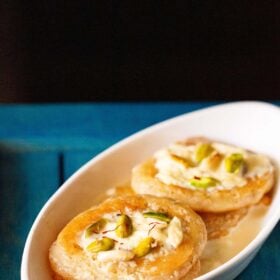
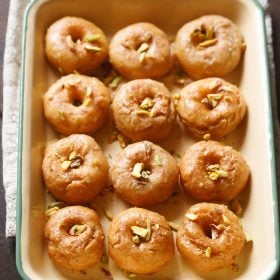
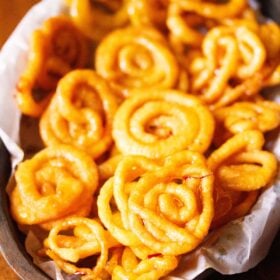
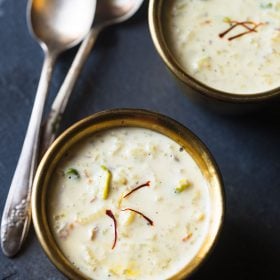
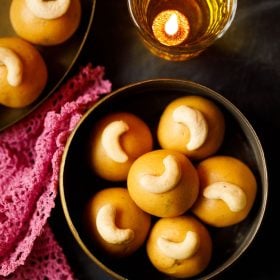
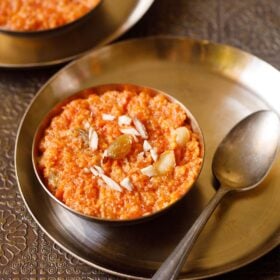
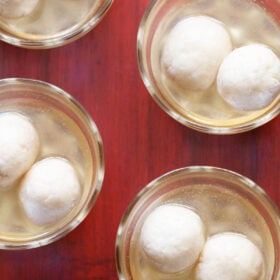
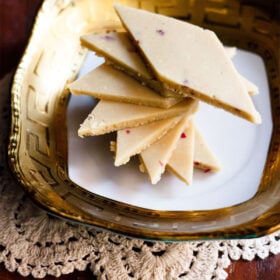








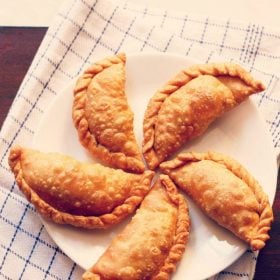
Can you make the stuffing before hand and freeze it?
You can do that but ensure to thaw the stuffing and bring it to room temperature before filling it in the gujiya pastry.
Hello Dassana,
I was wondering if it’s possible to replace khoya with something else (eg. milk powder or condensed milk)?
Thanks in advance 🙂
Hi Simi, milk powder will work. With milk powder if it is sweet, reduce the sugar and add some milk/water to moisten it. Condensed milk will work in combination with milk powder. You won’t need to add sugar if you use condensed milk and milk powder together.
Thanks a lot for your response.
Great
I tried your recipe exactly as described. Unfortunately, the gujjiyas started splitting in the oven and the filling started oozing out. What went wrong? Why would this happen? All the gujjiyas were sealed perfectly well. I used 2 c all purpose flour instead of a combination. Thanks!
Looks like the stuffing had lot of moisture and while baking they moisture and liquids starting releasing. The khoya or mawa should be cooked well and should not have any liquid in them. I hope you have used powdered sugar and not castor sugar. Castor sugar are very fine granulated sugar and can release moisture. Here the type of flour is not the problem, but the stuffing is. I hope this helps.
Hi Dassana,
I have been following your website since long. I’m highly impressed with your knowledge about so many recipes and how you prepare them with so much love! It’s an beautiful art! Your effort of sharing the knowledge makes a huge difference in our lives. My heart felt thanks to you.
thank you much vaishnavi. so glad to read your comment and made me feel good too. thanks again and happy cooking.
Hi, is it OK to roll out a large circle of the dough and cut out small circles from it for the gujiya? We are making a really big batch for diwali and my rolling skills are subpar. Thanks in advance 🙂
yes you can do this way too tanaya.
Hi Dassana, I always check your recipes to clear my doubts especially baking stuff. I tried this one gujiya, they puffed up beautifully and was crispy when it was hot, later they lost their crispness after storing them. Where have I gone wrong?
thanks priya. the gujiyas need to cool completely before you store them. if stored when they are slightly hot or even warm then due to moisture released from condensation they will loose their crispness. hope this helps.
Hello !!
I made gujiyas for the first time ever last year and followed the recipe to the T. The results were AWESOME !! Perfect gujiya with the perfect amount of sweetness. My toddler loved it. I’m planning to make em for Diwali this year and I had a question, can I double the recipe ? Shud I just add everything twice to make double amount (last year it yielded 30 bite-sized gujiyas) . Also can I half the recipe, like if I want to make smaller batch than the one u mentioned, can I just use half of the ingredients? Thank you in advance !!
thank you meA. glad to know. of course the recipe can be halved or doubled. just halve or double the ingredients proportionately. wish you happy diwali in advance.